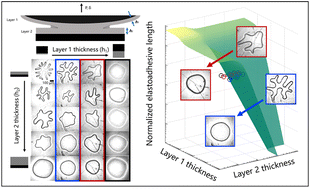Geometry-controlled instabilities for soft–soft adhesive interfaces†
Abstract
Soft materials interfaces can develop complex morphologies, such as cavities or finger-like features, during separation as a result of a mechanical instability. While the onset and growth of these instabilities have been investigated previously for interfaces between rigid and soft materials, no existing predictive model provides insight for controlling the separation morphology associated with these instabilities when both “sides” of the interface are soft. Here, we expand previous models to account for the geometry and materials properties of two soft materials that form an interface. The total compliance of the system, which depends nonlinearly on the thickness of each contacting soft material, plays a primary role in governing the morphology of the separating interface. We validate this model with experimental measurements using a series of soft elastomers with varying layer thicknesses and fixed materials properties, in order to emphasize the geometry alone can give rise to the observed differences in the interface separation process. This model also demonstrates that the degree of geometric asymmetry, or the ratio of the layer thicknesses that form an interface, influences the stress experienced in either layer, thus providing a rich means of controlling how unstable interface separations develop and propagate. This framework is a powerful tool to understand and control adhesion mechanisms in fields ranging from biology to soft robotics, and provides intuition for engineering a separation mode for a desired end result.



 Please wait while we load your content...
Please wait while we load your content...